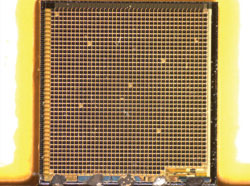Subretinal implant provides stable percepts synchronized with eye movement
Click Here to Manage Email Alerts
FORT LAUDERDALE, Fla. — A subretinal electronic implant with a light-sensitive chip provided stable visual images tracking objects with regular eye movement, a speaker said here.
“Due to microsaccades, images are constantly refreshed at different retinal locations, and due to the feedback of information about eye position to the brain, a stable percept is created. So, our patients perceive a continuous stable image,” Eberhart Zrenner, MD, PhD, said at the Association for Research in Vision and Ophthalmology meeting.
Dr. Zrenner and colleagues set out to compare subretinal electrode-generated percepts generated by stationary stimulation with percepts elicited by light-sensitive subretinal arrays during voluntary eye movements. The implant was developed by Retina Implant and tested at the University Eye Hospital in Tübingen, Germany.
Continuous stimulation of fixed electrodes can provide only quickly fading percepts, Dr. Zrenner and colleagues said in the abstract.
“If our image in the eye is optically stabilized, after a few seconds it will completely disappear,” Dr. Zrenner said.
Conversely, because of saccadic and fixational eye movement, percepts of images constantly moving across the subretinal light-sensitive chip remain visible without measurable temporal limitation, the authors said.
Photodiodes mimic photoreceptors
Blind patients who lose photoreceptor cells retain retinal bipolar and ganglion cells for many years. The subretinal implant’s light-sensitive photodiodes assume the function of photoreceptor cells and transmit electrical charges to bipolar cells that subsequently stimulate ganglion cells.
A retinal implant and surviving inner retinal cells can restore some vision based on two principles currently under development, Dr. Zrenner said.
 A light-sensitive chip, part of a subretinal electronic implant, is inserted into the subretinal space and provides stable percepts synchronized with natural eye movement. |
 Funduscopy image of a light-sensitive subretinal chip that is a key component of an electronic implant that provides stable percepts with real-time, natural eye movement. Images: Retina Implant |
“One is to have a camera outside the body, somehow fixed to, say, glasses,” he said. “An image processor then provides signals to a readout device, in this case on the epiretinal side, which, itself, has no light-sensitive photoreceptors. The other approach, the one we are using, is a subretinal implant that has photodiodes right at each of the pixels, each with its own amplifier and electrode.”
The light-sensitive chip has 1,500 such pixels on an area of 3 × 3 mm and is approximately 100 µm thick. The quadratic electrodes on the chip are 50 µm in size and 70 µm apart, Dr. Zrenner said.
Additionally, the implant comprises a 4 × 4 mm electrode field controlled externally for direct electrical stimulation. Both arrays stimulate fixed retinal positions, but light-mediated stimulation from the photodiode array follows unrestricted eye movements, Dr. Zrenner and colleagues said in the study abstract.
The implant has a subdermal power line located under the scalp, behind the patient’s ear.
“It’s put into the subretinal space,” Dr. Zrenner said. “Light is exciting these photodiodes and current is released to the bipolar cells in a natural way, point by point. … So, you could say an electrical image is then transmitted point by point through the nerve fibers to the optic nerve and to the brain.”
Continuous percepts
A pilot human study included 12 blind patients with a subretinal implant.
Results showed that consecutive percepts faded among seven patients tested with electrical stimulation at fixed retinal positions. However, with the light-sensitive chip, patients perceived constant images with natural eye movement.
Investigators applied two consecutive stimuli to the implant. Applying paired pulses at 4 Hz resulted in a 50% chance of direct stimulation. However, when the paired pulses were applied to neighboring electrodes and not just one electrode, the percentage of simulation was much greater, Dr. Zrenner said.
Applying light stimulation to the photodiodes prevented image percepts from fading, he said.
“The patient can see the image constantly as a complete entity,” Dr. Zrenner said. “It doesn’t have to have him move his eyes, nor does he have to move his head, nor does he need to move constantly his eyes once he has found the object.”
Dr. Zrenner and colleagues concluded that the brain requires real-time information of eye movements to generate stable percepts. This is only possible if the light-sensitive part of the implant moves in perfect unison with the eye, as occurs in the subretinal microphotodiode implant, they said. – by Matt Hasson

- Eberhart Zrenner, MD, PhD, can be reached at Institute for Ophthalmic Research, Schleichstrasse 12-16, D-72076, Tübingen, Germany; 49-7071-29-84786 or 29-87311; fax: 49-7071-29-5083; e-mail: ezrenner@uni-tuebingen.de. Dr. Zrenner is one of the founders of Retina Implant but receives no compensation for advisory tasks other than travel reimbursement.
